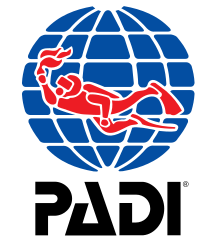Professional Association of Diving Instructors
 |
|
| Abbreviation | PADI |
|---|---|
| Motto | The Way the World Learns to Dive |
| Formation | 1966 |
| Headquarters | Rancho Santa Margarita, California, United States |
|
Region served
|
International |
|
Membership
|
over 136,000 dive professionals, 6200 dive centers and resorts |
| Leader | Drew Richardson |
|
Parent organization
|
PADI Worldwide Corp. |
| Affiliations |
DSAT Project AWARE Emergency First Response Current Publishing |
| Website | http://www.padi.com |
The Professional Association of Diving Instructors (PADI) is the world's largestrecreational diving membership and diver training organization founded in 1966 by John Cronin and Ralph Erickson. Cronin was originally a NAUI instructor who decided to form his own organization with Erickson, and to break diver training down into several modular courses instead of the single universal course then prevalent.
PADI courses range from minimal entry level to relatively advanced recreational diver certification, several specialized diving skills courses, usually connected with specific equipment or conditions, some diving related informational courses and a range of recreational diving instructor certifications. Under the PADI TecRec brand, they also offer various technical diving courses. PADI's sister company Emergency First Response Corp provides a range of first aid and CPR programs for lay people, including workplace specific programs in Australia, Canada and the UK.
PADI claims to be the leading training agency for scuba diving in the world. As of 2016[update] it has a membership of over 136,000 individuals and 6,300 dive centers, and has awarded more than 24,000,000 diving certifications internationally.
PADI courses are performance-based diver training programs, and at the introductory level emphasize practical knowledge, safety and motor skills. The basics of diving physics and physiology are introduced during entry level programs. The details of these concepts are left for later courses when they are necessary for the required competences of the specific training. These practices fall within current modern learning philosophies and receive regular updates via peer review.
The PADI training system is composed of modules with standardized learning objectives divided into theory and practical skills development. Each module is a stand-alone course for which certification is provided to the participant on successful completion of the course. Theory is mainly conveyed by way of self-study using books, computer-based training using CD-ROM or online learning. All study options are supplemented with video and, in most cases, live instruction to help the participant visualize what they have read. Confirmation of the student diver's level of mastery in standardized knowledge review sessions is carried out by a scuba instructor. The instructor utilizes both written tests and live observation during actual dives to verify a student's knowledge and skills. Practical skills are obtained through confined water training (pools or relatively shallow water) and performance evaluations in open water.
...
Wikipedia
